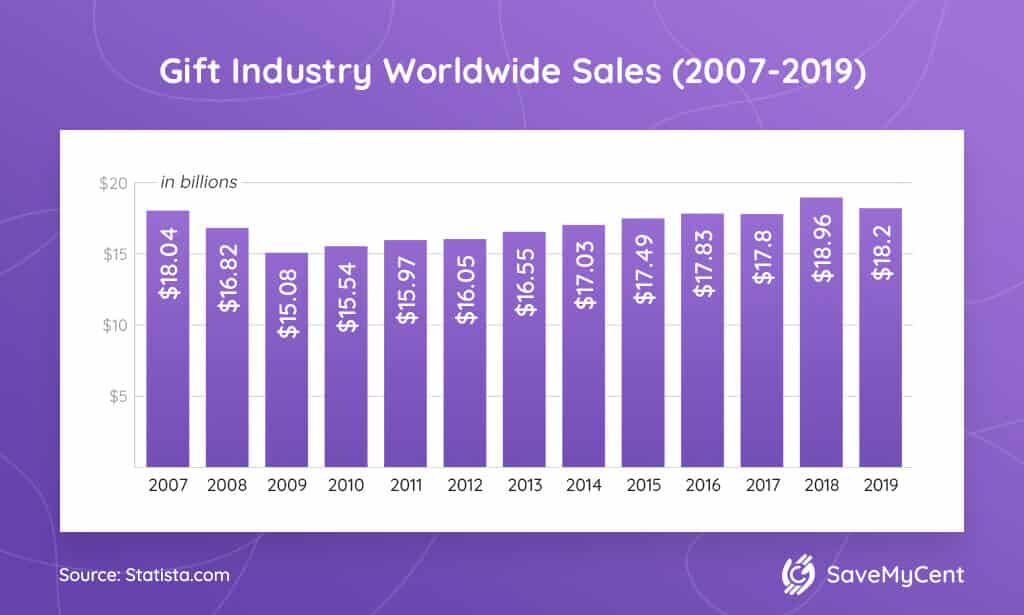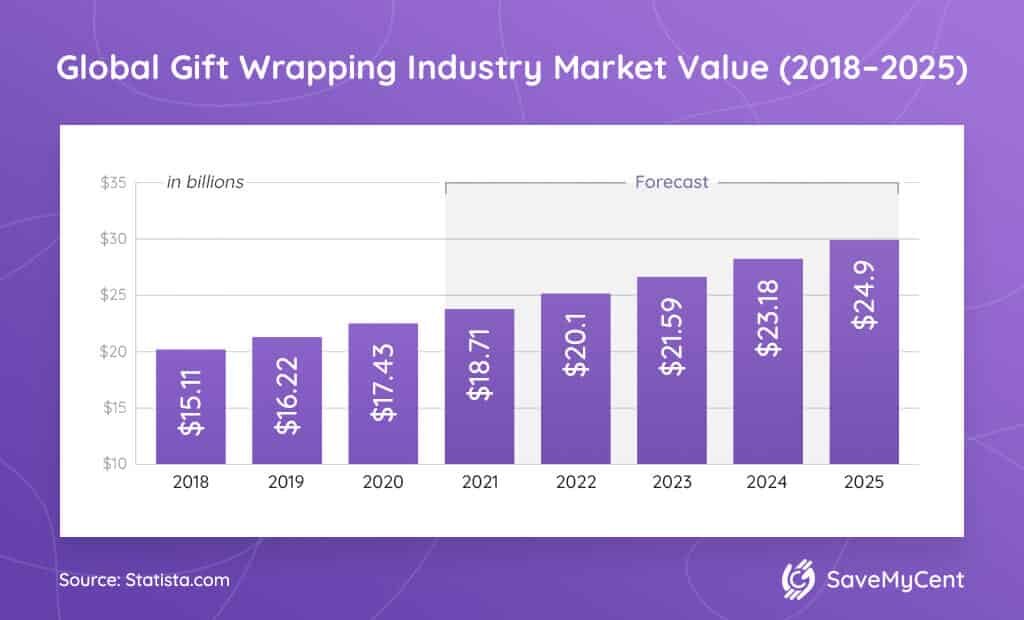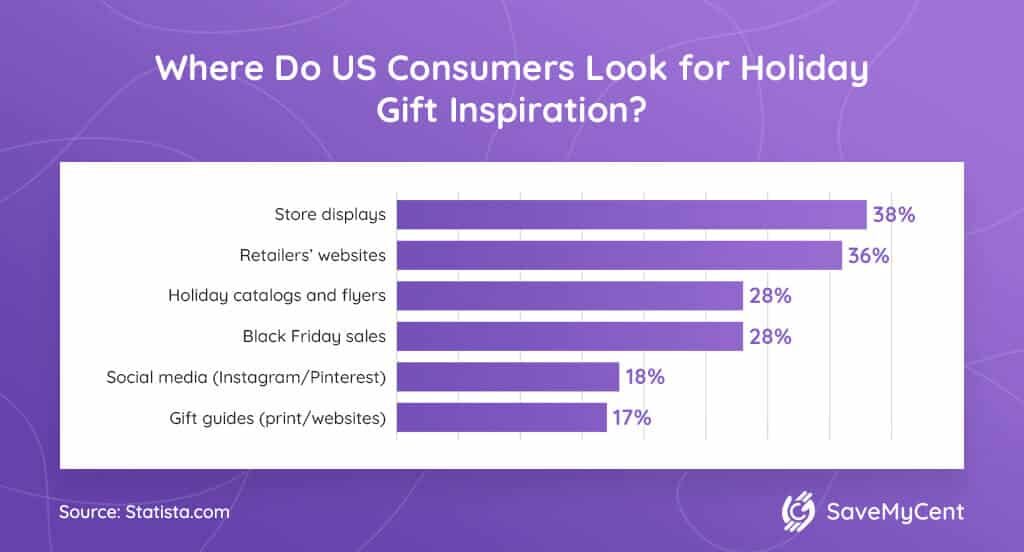The gifting ritual is as old as society. Regardless of the occasion, people have been giving each other gifts for centuries — and not even the global pandemic could stop that tradition.
In the face of ever-changing consumer habits, the gift industry is constantly evolving.
This gift industry statistics overview will discuss both recent and historical market trends, highlight the emerging personalized gift sector, and explore interesting customer habits that continue to shape the market. Through all this, we’ll examine how the industry has changed in recent years and how the COVID-19 pandemic affected its revenue and future prospects.
Top Gift Industry Statistics (Editor’s Choice)
- The global gift market’s worth is currently estimated at $62 billion.
- The US corporate gift market was worth $242 billion by the end of 2021.
- The global gift wrapping sector is currently worth $17.43 billion.
- In 2020, the global personalized gifts market was worth $25.8 billion.
- 62% of Americans prefer personalized gifts over costly store-bought items.
- Gift cards are among the three most popular holiday gift choices in the US.
- 38% of consumers look at physical store displays for gift inspiration.
- 58% of women would like to receive jewelry as a gift.
Essential Gift Industry Stats
1. The global gift market’s worth is currently estimated at $62 billion.
(Wonder, Research and Markets)
Growing at an annual rate of 2%, the market is expected to reach $68.45 billion by the end of 2024. However, experts warn that the market may be worth significantly more, as there are practical difficulties with these gift industry stats. Namely, tracking the sales of products labeled as giftware is challenging, as they fall into many different categories. The official data thus primarily relates to traditional giftware items like souvenirs, gift bags, and gift baskets.
2. It took 10 years for the gifting industry to recover from the global financial crisis.

Since the beginning of the 1990s, the gift industry had been steadily increasing its annual revenue — until 2008 when it went down from $18.04 billion to $16.82 billion. In 2009, its revenue dropped even further to $15.08 billion. Although the decrease wasn’t that drastic, it took an entire decade for these numbers to go back to their pre-2008 levels. This happened in 2018 when the industry generated $18.96 billion in revenue, marking a new all-time high.
3. According to gift card statistics, the global market was worth $1 trillion in 2020.
(GlobeNewswire)
Despite COVID-19, the global gift card market continued to thrive in 2020. China held the largest share at $608.1 billion, followed by the US at $278.8 billion. By 2027, the worldwide market is expected to reach $2.7 trillion, growing at an impressive annual rate of 14.5%. Digital gift cards are growing faster than other sectors — this segment currently accounts for 11% of the entire market’s revenue and is projected to grow by 15.5% annually until 2027.
4. The US corporate giftware market will be worth $242 billion by the end of 2021.
(GiftNow)
Experts continue to put emphasis on the corporate gift market as a great opportunity to advance the industry in general. The constantly expanding corporate market should reach $306 billion in revenue by 2024, growing at an annual rate of 8.1%. The shift to remote work amid the pandemic will be the main driver of this growth. On that note, 58% of US business owners say they’ve given the same amount or more gifts since switching to remote work.
5. Greeting card and gift stores revenue in 2021 is projected at $13.6 billion.
(IBISWorld)
According to gift industry market research, this number marks a 5.7% increase from 2020. However, it’s still insufficient to make up for that year’s massive drop in revenue. In 2019, these retail outlets generated $18.8 billion. As such, the projected 2021 revenue is 27.7% lower than what US gift and greeting card stores used to make before the pandemic struck.
6. An average gift shop generates $1,911 in revenue in its first year.
(Bplans)
Bplans, a professional business plan development company, projects that a small gift shop will only manage to turn 2.92% of its sales into profits during its first year. But things improve the longer the store stays in business. According to their projections, this number may go up to 5.75% in the second and 10.9% in the third year. By that time, a small gift shop may be generating a revenue of $10,690 — and that’s excluding the $36,000 in payroll money.
7. The global gift wrapping industry is currently worth $17.43 billion.

Predictions state that the market worth should reach $24.9 billion by 2025, continuing the steady growth from the previous years. The demand for gift wrapping is especially visible with gift boxes. Due to the rise of ecommerce in recent years, merchants are continuously working on creating durable gift boxes that can withstand various transportation conditions.
8. The US gift box industry is responsible for 2.3 million pounds of waste each year.
(Earth911)
As much joy as a perfectly wrapped present may bring to the recipient, there’s a flipside one needs to consider. Namely, 2.3 million of the 4.6 million pounds of wrapping paper produced each year ends up in landfills. Most of the waste comes from materials like paper, aluminum, and plastic. And not all wrapping paper is recyclable. For example, it cannot be recycled if it has glitter, metallic elements, or lifted texture. Likewise, bows and ribbons are not recyclable.
9. Gift basket industry statistics show that businesses in this sector average $65,700 per year in profit.
(Profitable Venture)
While gift baskets might seem outdated to some, data shows this niche can still be profitable for businesses. Annual net earnings will depend on many factors, including the longevity of the venture. Starting at $120,000 in their first year, gift basket businesses can end their third year with $250,000 in revenue before taxes. Interestingly, research reveals this is the period by which the majority of businesses in this sector break even and begin operating at a profit.
Personalized Gift Industry Trends
10. In 2020, the global personalized gift sector was worth $25.8 billion.
(PR Newswire)
The demand for personalized gifts has been growing steadily over the past decade. As merchants find new ways to offer gift personalization to customers, the market’s worth keeps increasing. By current estimations, the gift industry revenue will reach $43.3 billion by 2027. Interestingly, this is one of the rare industry sectors where the US has a lead over China — the US market is worth $7.6 billion, which is the value China is projected to reach by 2027.
11. 62% of Americans prefer personalized gifts over costly store-bought items.
(Vistaprint)
Personalized gift industry statistics from a recent consumer survey show that most US adults would rather receive a gift that feels personal and sentimental than a meaningless expensive item. And it’s not just the recipients that feel this way — 68% of Americans say they get more satisfaction out of giving someone a heartfelt gift than an expensive store-bought item.
12. 58% of people say they’re more likely to tell others about a personalized gift they received.
(Vistaprint)
Getting a personalized gift leaves a lasting impact on the recipient — 66% of Americans say they remember personalized gifts much longer than generic store-bought items. This could help spur the gift industry’s growth, as merchants offering personalization options for buyers are very likely to benefit from word of mouth marketing. Most often, these are retailers that provide photo gifts, handwritten notes, photo books, and customizable mugs and bedding.
13. Gift industry trends show that gift cards are still among the most popular Christmas presents.
(Statista, Vistaprint)
Although only 14% of Americans prefer receiving gift cards over something more personal, they’re constantly among the three most popular holiday gifts in the US. A recent survey supports these gift industry facts, as 48% of US adults bought at least one gift card during the holiday shopping season in 2020. What’s more, 76% say they plan to buy gift cards for their loved ones in 2021 — the top gift choice along with toys (76%) and clothing (77%).
14. Women are more likely to give DIY gifts for Valentine’s Day.
(Statista)
A look at gift industry trends in 2021 reveals that both men (39.1%) and women (33.5%) rely the most on brick-and-mortar stores for Valentine’s Day gifts. Ecommerce giant Amazon is their second top choice, with 38.5% of men and 34.6% of women buying their gifts there. But men are slightly more likely to stop their search for the perfect gift there. The data on DIY gifts illustrates this — 20.7% of women will give DIY gifts, as opposed to just 12.4% of men.
Gifting Trends and Consumer Habits
15. 38% of consumers look at physical store displays for gift inspiration.

Even though social media and websites play an important role, many consumers still like to go to physical stores and see what’s on display to get inspiration for their holiday gifts. The merchants’ official websites rank second, with 36% of customers looking for inspiration there. And while 28% each browse store catalogs and look at Black Friday sale offers, only 18% turn to social media for inspiration, and 17% look at gift guides in print and online.
16. 58% of women would like to receive jewelry as a gift.
(PR Newswire)
Giftware and jewelry statistics reveal the latter is a highly popular choice among women. Most women (57%) cite earrings as their top choice due to their versatility. Other popular options include necklaces (42%), bracelets (30%), and fashion rings (26%). Besides jewelry, women also like theater tickets (30%), perfumes (23%), and meals at restaurants (15%).
17. Chocolate is the least wanted gift among women.
(PR Newswire)
While many believe chocolate is a “safe bet” when buying a gift for women, gift industry statistics paint a different picture. According to a recent survey, 31% of women cite it as their least favorite gift. Other unwanted yet often received gifts include underwear and flowers (17% each). Oven gloves, suitcases, and vacuum cleaners round out the least wanted list.
Giftware Industry Overview: In Conclusion
Consumer habits and trends may be shifting, but the gift industry is as strong as it has ever been. After a decade-long recovery following the global financial crisis, the gift industry’s market size is currently valued at $62 billion and projected to reach $68.45 billion by 2024.
The personalized sector is gaining momentum and driving the industry’s growth, as the demand for heartfelt, custom-made gifts keeps increasing. Retailers are adapting to these changes by offering various personalization options to attract customers. And while they aren’t going anywhere, generic store-bought items are not as popular as they once were, with more and more people putting a gift’s sentimental value ahead of its financial value.
FAQ
What is giftware?
The term giftware relates to all items one can purchase and give others as gifts on suitable occasions. Because a lot of personal products can also serve as gifts, it is somewhat difficult to precisely define what falls into the giftware bracket. Gift bags and baskets, greeting cards, souvenirs, and gift cards are the sector’s core products. Apart from birthdays and personal occasions, the industry is mainly driven by big holidays like Christmas and Valentine’s Day.
How big is the gifting industry?
Seeing as most products sold for personal use can be purchased as gifts, it’s hard to define the exact gift industry sales. However, if we only look at sales of traditional gift items like gift bags, gift baskets, and souvenirs, the industry is currently worth $62 billion. Experts see it reaching $68.45 billion by 2024, growing at a compound annual rate of 2%. It’s important to note these numbers exclude the gift card industry, which is currently valued at $1 trillion.
Is the gift industry growing?
Yes, the industry has been growing since 2010, following a two-year decline as a result of the global financial crisis. As mentioned, its worth is currently estimated at $62 billion and projected to increase by $6.45 billion by 2024. The personalized gift industry is expected to grow even more — its current value is $25.8 billion and will go up to $43.3 billion by 2027.
Which country spends most on holiday gifts?
The gift industry is primarily driven by holidays, as this is when the majority of revenue is generated. Analyzing the data from the peak holiday period (November and December), UK shoppers spent the most in 2020, with an average of $1,360 per customer. The US came in second with an average of $1,200. The rest of the top five comprises Canada, Australia, and France — all three with an average holiday spending of under $1,000 per shopper in 2020.
How much does the average gift shop make?
According to business insiders, an average gift shop generates just $1,911 in profits during its first year. This translates to 2.92% of the store’s total sales. However, the longer the shop stays in business, the more profits it will make. Gift industry statistics reveal that the share of the profits typically goes up to 5.75% in the second and 10.9% in the third year. By that point, the profits average $10,690, along with $36,000 in payroll money for the employees.
Sources:







![How to Get Free Clothes From Shein? [2024 Guide]](https://savemycent.com/wp-content/uploads/2023/09/How-to-Get-Free-Clothes-From-Shein-336x220.png)
